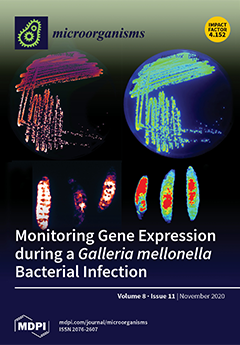The relationship among bats, ectoparasites and associated microorganisms is important to investigate how humans can become exposed to zoonotic agents. Even though the diversity of
Bartonella spp. in bats and ectoparasites has been previously reported, the occurrence of
gltA genotypes within hosts has
[...] Read more.
The relationship among bats, ectoparasites and associated microorganisms is important to investigate how humans can become exposed to zoonotic agents. Even though the diversity of
Bartonella spp. in bats and ectoparasites has been previously reported, the occurrence of
gltA genotypes within hosts has not been assessed so far. We aimed to investigate the genetic diversity of
Bartonella spp. in non-hematophagous bats and associated ectoparasites by assessing cloned
gltA Bartonella genotypes in intra- and inter-hosts levels, as well as by using three additional molecular markers. Overall, 13.5% (18/133) bat blood samples, 17.18% bat flies (11/64) and 23.8% (5/21) Macronyssidae mite pools showed to be positive for
Bartonella spp. Seventeen positive samples were submitted to
gltA-cloning and three clones were sequenced for each sample. We also obtained 11, seven and three sequences for
nuoG,
rpoB and
ftsZ genes, respectively. None were positive for the other target genes. We found at least two genotypes among the three
gltA-cloned sequences from each sample, and 13 between all the 51 sequences. Among the
nuoG,
rpoB and
ftsZ sequences we found eight, five and three genotypes, respectively. In the phylogenetic analysis, the sequences were positioned mainly in groups related to
Bartonella identified in rodents, bats and bat flies. Herein, we showed the genetic diversity of
Bartonella in bat’s blood and associated ectoparasites samples at both intra- and inter-host levels.
Full article






